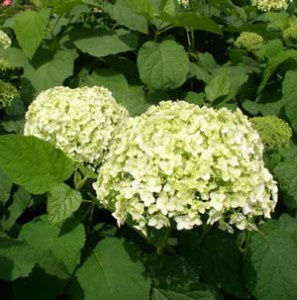Hydrangea arborescence – Pruning, Winter Care and Fertilizing

Flower
Includes Annebelle, Â Incrediball
In our area, these shrubs are almost herbaceous, that is, after most winters they die to the ground. Because of this, they usually require no more than removing the dead canes in early spring before they leaf out. If the plant has died back to the ground, a clean cut about 2″ above ground line is best. However, care should be taken not to remove any viable stems or injure any new buds.
By fertilizing young shrubs you can increase both the size and the amount of flowers on the plant. Granular, liquid or stake type fertilizers can be used. Granular types should be worked into the soil around the plant at a rate of 2 pounds or 2 pints per 100 square feet of planting bed. An alternative way is to drill or punch 6″ deep holes at the drip line of the plant. Poured into these holes should be a total of 1/4 pound of fertilizer per foot of height or spread of the shrub (divided up and poured evenly between all of the holes). These holes should not be filled with more than 1/3 of the fertilizer and then they should be top filled with soil. This method of fertilization should only be done once a year, and is best done in late fall after leaf drop, or in early spring before bud break.
Liquid fertilizers (such as Miracle Gro) are mixed with water and applied the same as you would water the plant (see product for specific details). This should be done three or four times per year starting in late April and ending in mid July. Stake type fertilizers can be used following the directions on the package. With any of the above techniques a balanced mix should be used, 20-20-20 or 20-30-20 or 18-24-16. Organic fertilizers, like manure, can also be used with good results. This material should be worked into open soil at a rate of one bushel per one 6′ shrub or 100 sq. ft. of bed area.
These shrubs need little winter care but, should be occasionally checked for rabbit or other damage. If rabbit damage is found you can protect the plant with a fence formed with hardware cloth (looks like chicken wire but with small square holes). The branches of the plant should be tied in towards the center, then a circle of hardware cloth can be placed around the outside. The base of the hardware cloth should be buried in the soil or mulch. This protection should be installed in late November and removed in mid April.
